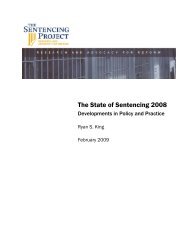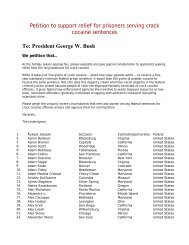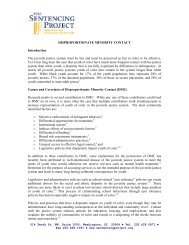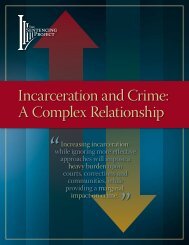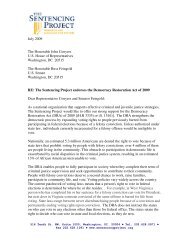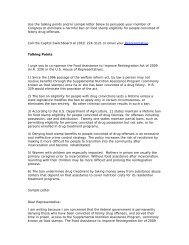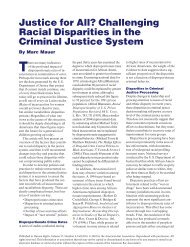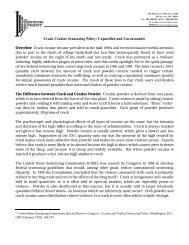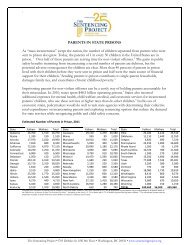VIEW PDF - The Sentencing Project
VIEW PDF - The Sentencing Project
VIEW PDF - The Sentencing Project
You also want an ePaper? Increase the reach of your titles
YUMPU automatically turns print PDFs into web optimized ePapers that Google loves.
continuation of efforts to reduce the use of incarceration and other residential<br />
facilities.<br />
Improve School Safety and Reduce Harsh Disciplinary Practices<br />
Academic success plays a critical role in preventing delinquent behavior and<br />
promoting positive outcomes for youth and safer communities. Youth who drop out<br />
or are pushed out of school find themselves with fewer opportunities for gainful<br />
employment and are more likely than youth who remain in school to commit<br />
delinquent acts. In 2006‐2007, nearly 10% of young male high school dropouts<br />
were institutionalized on a given day compared to only 3% of high school graduates<br />
and less than .1% of college graduates. 11 In addition, out‐of‐school suspension and<br />
expulsion are being overused and disproportionately affect youth of color, students<br />
with disabilities, and LGBT youth. According to the Dignity in Schools campaign,<br />
each year more than three million students are suspended and over 100,000 are<br />
expelled nationally. 12 African‐American students (nearly 3 times as likely to be<br />
suspended and 3.5 times as likely to be expelled as white students) and Latino<br />
students (1.5 times as likely to be suspended and twice as likely to be expelled as<br />
white students) bear a disproportionate burden of these punishments when<br />
compared to their white peers. 13 Students with disabilities also experience<br />
disciplinary removal from the classroom at rates that are disproportionate to their<br />
overall representation in the K‐12 population. 14 A recent study indicates that nonheterosexual<br />
youth are expelled at disproportionate rates. 15<br />
<strong>The</strong> Administration should help schools improve school safety and keep the<br />
maximum number of students in their regular educational placements by providing<br />
training and technical assistance to schools on how to use alternatives to<br />
suspension and expulsion, family and tutoring supports, social and emotional<br />
learning, positive youth development programming, bullying prevention, threat<br />
assessment, positive behavior supports, and restorative justice practices.<br />
Examine the Role and Impact of Mental Health and Substance Abuse Disorders<br />
We are encouraged that OJJDP proposed to fund an initiative in partnership with<br />
the Department of Health and Human Services to identify best practices for juvenile<br />
drug courts and adolescent treatment. As an extension of that initiative, OJJDP, in<br />
coordination with the Substance Abuse and Mental Health Services Administration,<br />
should conduct a major study regarding the prevalence of mental health and<br />
substance abuse disorders among juvenile justice populations served by all U.S.<br />
States and territories. According to recent data released by OJJDP, 44 percent of<br />
youth in custody say they were under the influence of alcohol or drugs during the<br />
commission of their offense. 16 Additionally, OJJDP should increase training and<br />
technical assistance related to mental health and substance abuse, including best<br />
practices for law enforcement and probation officers, detention/corrections and<br />
community corrections personnel, court services personnel and others.<br />
5



